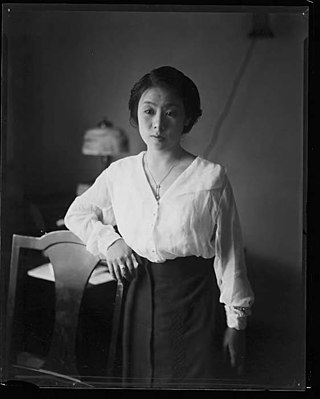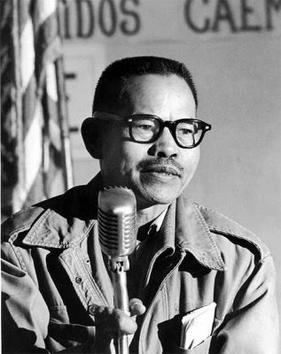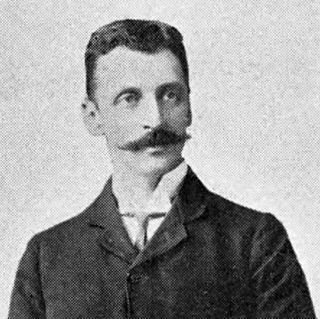
Hawaii is an island state of the United States, in the Pacific Ocean about 2,000 miles (3,200 km) southwest of the U.S. mainland. It is the only state not on the North American mainland, the only state that is an archipelago, and the only state in the tropics.

Kalākaua, sometimes called The Merrie Monarch, was the last king and penultimate monarch of the Kingdom of Hawaiʻi, reigning from February 12, 1874, until his death in 1891. Succeeding Lunalilo, he was elected to the vacant throne of Hawaiʻi against Queen Emma. Kalākaua had a convivial personality and enjoyed entertaining guests with his singing and ukulele playing. At his coronation and his birthday jubilee, the hula, which had hitherto been banned in public in the kingdom, became a celebration of Hawaiian culture.

The Territory of Hawaii or Hawaii Territory was an organized incorporated territory of the United States that existed from April 30, 1900, until August 21, 1959, when most of its territory, excluding Palmyra Island, was admitted to the United States as the 50th U.S. state, the State of Hawaii. The Hawaii Admission Act specified that the State of Hawaii would not include Palmyra Island, the Midway Islands, Kingman Reef, and Johnston Atoll, which includes Johnston Island and Sand Island.

Native Hawaiians are the Indigenous Polynesian people of the Hawaiian Islands.

The Newlands Resolution, 30 Stat. 750, was a joint resolution passed on July 7, 1898, by the United States Congress to annex the independent Republic of Hawaii. In 1900, Congress created the Territory of Hawaii.

The Native Hawaiian Government Reorganization Act of 2009 S1011/HR2314 was a bill before the 111th Congress. It is commonly known as the Akaka Bill after Senator Daniel Akaka of Hawaii, who proposed various forms of this bill after 2000.

Historic Filipinotown is a neighborhood in the city of Los Angeles.
Native American Day is a holiday observed in several US states in celebration of Native American culture. In California and Nevada, the holiday is designated on the fourth Friday of September, whereas in South Dakota and Wisconsin, it falls on the second Monday of October. Within each of these states, Native American Day honors the cultural contributions of Native American communities to the respective state's history, as well as to the overall country. The state of Washington celebrates Native American Heritage Day on the Friday immediately following the fourth Thursday in November. The state of Tennessee observes a similar American Indian Day each year on the fourth Monday of September. President George W. Bush signed into law legislation introduced by Congressman Joe Baca (D-Calif.), to designate the Friday after Thanksgiving as Native American Heritage Day.
Women's History Month is an annual observance to highlight the contributions of women to events in history and contemporary society. Celebrated during March in the United States, the United Kingdom, and Australia, corresponding with International Women's Day on March 8, it is observed during October in Canada, corresponding with the celebration of Persons Day on October 18.
Asian American, Native Hawaiian and Pacific Islander Heritage Month is observed in the United States during the month of May, and recognizes the contributions and influence of Asian Americans, Native Hawaiians and other Pacific Islander Americans to the history, culture, and achievements of the United States.
The Filipino American National Historical Society (FANHS) is a nonprofit organization that documents Filipino American history.

Asian American history is the history of ethnic and racial groups in the United States who are of Asian descent. The term "Asian American" was an idea invented in the 1960s to bring together Chinese, Japanese, and Filipino Americans for strategic political purposes. Soon other groups of Asian origin, such as Korean, Indian, and Vietnamese Americans were added. For example, while many Chinese, Japanese, and Filipino immigrants arrived as unskilled workers in significant numbers from 1850 to 1905 and largely settled in Hawaii and California, many Vietnamese, Cambodian, and Hmong Americans arrived in the United States as refugees following the Vietnam War. These separate histories have often been overlooked in conventional frameworks of Asian American history.

Cesar Chavez Day is a U.S. federal commemorative holiday, proclaimed by President Barack Obama in 2014. The holiday celebrates the birth and legacy of the civil rights and labor movement activist Cesar Chavez on March 31 every year.

Thelma Garcia Buchholdt was a Filipino American community activist, politician, historian, public speaker, cultural worker, and author. She was elected to the Alaska House of Representatives for four consecutive terms, from 1974 through 1982. She was the author of the book Filipinos in Alaska: 1788-1958, which is now in its third printing and is available through the Anchorage Museum at Rasmuson Center.
Same-sex marriage has been legally recognized in Nevada since October 9, 2014, when a federal district court judge issued an injunction against Nevada's enforcement of its same-sex marriage ban, acting on order from the Ninth Circuit Court of Appeals. A unanimous three-judge panel of the Ninth Circuit had ruled two days earlier that the state's ban on same-sex marriage was unconstitutional. Same-sex marriage was previously banned by an amendment to the Constitution of Nevada adopted in 2002. The statutory and constitutional bans were repealed in 2017 and 2020, respectively.

The history of Filipino Americans begins in the 16th century when Filipinos first arrived in what is now the United States. The first Filipinos came to what is now the United States due to the Philippines being part of New Spain. Until the 19th century, the Philippines continued to be geographically isolated from the rest of New Spain in the Americas but maintained regular communication across the Pacific Ocean via the Manila galleon. Filipino seamen in the Americas settled in Louisiana, and Alta California, beginning in the 18th century. By the 19th century, Filipinos were living in the United States, fighting in the Battle of New Orleans and the American Civil War, with the first Filipino becoming a naturalized citizen of the United States before its end. In the final years of the 19th century, the United States went to war with Spain, ultimately annexing the Philippine Islands from Spain. Due to this, the history of the Philippines merged with that of the United States, beginning with the three-year-long Philippine–American War (1899–1902), which resulted in the defeat of the First Philippine Republic, and the attempted Americanization of the Philippines.

Modesto "Larry" Dulay Itliong, also known as "Seven Fingers", was a Filipino-American union organizer. He organized West Coast agricultural workers starting in the 1930s, and rose to national prominence in 1965, when he, Philip Vera Cruz, Benjamin Gines and Pete Velasco, walked off the farms of area table-grape growers, demanding wages equal to the federal minimum wage, that became known as the Delano grape strike. He has been described as "one of the fathers of the West Coast labor movement."

Francis March Hatch was an American lawyer, businessman and politician who served as vice president of the Provisional Government of Hawaii, Minister of the Office of Foreign Affairs and Envoy Extraordinary and Minister Plenipotentiary to the United States for the Republic of Hawaii, and a Hawaiian Supreme Court justice. As the Envoy Extraordinary and Minister Plenipotentiary to the United States, he led the negotiation for the Republic of Hawaii during its annexation.
During its existence, the Republic of Artsakh and the United States did not have official diplomatic relations as the United States was among the vast majority of countries that did not recognize Artsakh as a sovereign nation and instead recognized the region of Artsakh, or Nagorno-Karabakh, as part of Azerbaijan. Despite no formal relations, the Republic of Artsakh had a representative office in Washington, D.C. since November 1997. It is not known whether the office still functions after the apparent dissolution of Artsakh.
H.Res.371 — 111th Congress (2009-2010) established National African Immigrant Heritage Month. to be celebrated during the month of September, recognizing the impact that African Immigrants in America play in the shaping of the country.












